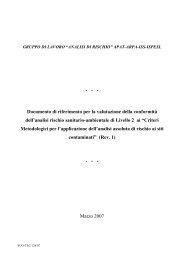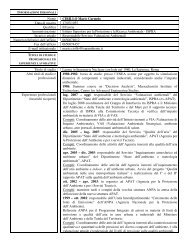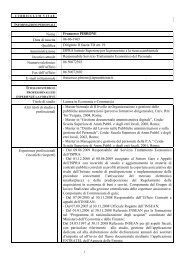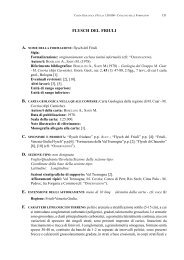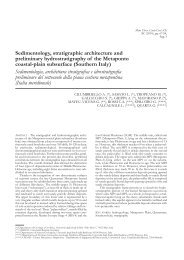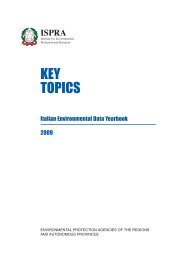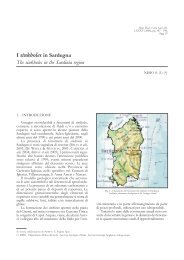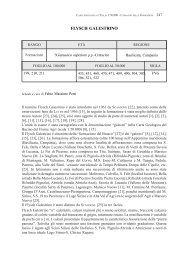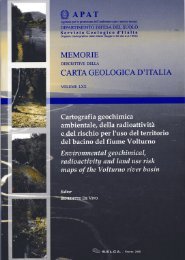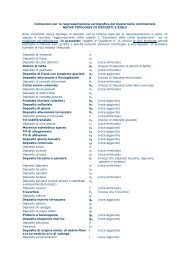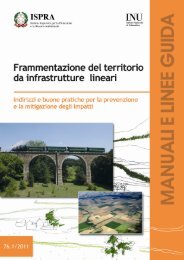Guidebook - Ispra
Guidebook - Ispra
Guidebook - Ispra
You also want an ePaper? Increase the reach of your titles
YUMPU automatically turns print PDFs into web optimized ePapers that Google loves.
THE APULIA CARBONATE PLATFORM-MARGIN AND SLOPE, LATE JURASSIC TO<br />
EOCENE OF THE MAIELLA MT. AND GARGANO PROMONTORY:<br />
PHYSICAL STRATIGRAPHY AND ARCHITECTURE P18<br />
Introduction<br />
The main goals of this fi eld trip are the stratigraphic<br />
architecture of the eastern margin of the Apulia<br />
Carbonate Platform (ACP) and the associated<br />
slope and basin sediments, along the unique onland<br />
outcrop areas of this vast carbonate platform<br />
(Maiella Mountain and Gargano Promontory).<br />
The ACP represents a case study of a margin with<br />
different evolutionary stages through time, from a<br />
progradational to aggradational and from erosional to<br />
by-pass. Spectacular geometries and different systems<br />
are visible, in some cases at the seismic scale, with<br />
various facies associations and physical stratigraphic<br />
relationships. Onlap, interfi ngering, erosional features<br />
at different scale, slumpings, breccia bodies, graded<br />
beds, pelagics, are the main geometric features<br />
and associated sedimentary products. Drowning<br />
unconformities, scalloped margins and coalescence<br />
of various platform systems also characterize the<br />
evolution of this carbonate platform through time.<br />
The fi rst day will be spent to travel from Florence to<br />
the Maiella Mountain, in the Abruzzo Region. During<br />
the second day, the fi eld trip will start on the Maiella<br />
and focus on its spectacular abrupt contact between<br />
the platform facies and slope-to-basin sediments. In<br />
the late afternoon we will travel to the town of Vieste,<br />
in the eastern corner of the Gargano Promontory<br />
(Apulia Region). The third day we will start with<br />
a panoramic view of the sea-cliff (Pizzomunno) of<br />
the old town of Vieste, where an erosional surface<br />
between the Upper Cretaceous pelagic sediments and<br />
Middle Eocene calciturbidites and breccia bodies is<br />
clearly visible. Then we will move along the eastern<br />
coast of the Gargano to observe spectacular slumpings<br />
and breccia bodies in the basinal Maiolica Fm (Lower<br />
Cretaceous), and will reach the Mattinata area where<br />
the Maiolica Fm unconformably onlaps the fl ank of<br />
the underlying drowned platform. At the end of the<br />
day we will visit the Saraceno Mountain where, in<br />
a hundred meters high sea-cliff, is clearly visible<br />
the transition between Middle Eocene clinostratifi ed<br />
strata and sub-horizontal basinal sediments. The forth<br />
day will be spent in the Belvedere di Ruggiano area<br />
to observe the abrupt contact between Berriasian<br />
platform facies and Upper Cretaceous base-of-slope<br />
deposits. Then we move to the Val Carbonara section,<br />
where the interfi ngering between Lower Cretaceous<br />
margin and slope deposits is well exposed. These<br />
are abruptly truncated by a huge mid-Cretaceous<br />
Leaders: M. Morsilli, G. Rusciadelli, A. Bosellini<br />
megabreccia event. The last stop of this fi eld trip will<br />
be in the Borgo Celano quarry, where many dinosaurs<br />
footprints have been recently discovered in a peritidal<br />
succession. In the late afternoon we will start to return<br />
to Florence.<br />
Topographic maps<br />
Maiella area: I.G.M.I. maps (Istituto Geografi co<br />
Militare Italiano), scale: 1:100.000, Foglio n° 147,<br />
Lanciano. Scale: 1:25.000, Tavoletta 147IIINE<br />
“Pennapiedimonte”.<br />
Gargano Area: I.G.M.I. maps, scale: 1:50.000,<br />
Foglio n° 385, Vieste, F. n° 398 Mattinata, F. n° 397<br />
Manfredonia.<br />
Geological Maps<br />
Maiella area: Donzelli G. (1968) Carta geologica<br />
della Maiella, Dipartimento di Scienze della Terra,<br />
Università di Chieti eds. Carta Geologica d’Italia,<br />
scale 1:100.000 F. n° 147 Lanciano. Vezzani and<br />
Ghisetti (1997) Carta Geologica dell’Abruzzo, scale<br />
1:100.000, SELCA eds.<br />
Gargano Area: Carta Geologica d’Italia, scale 1:<br />
100.000 F. n° 156 San Marco in Lamis; F. n° 157<br />
M.S. Angelo.<br />
Guide Books<br />
Maiella area: Guide Geologiche Regionali n° 10<br />
Abruzzo, BEMA Eds., 2003;<br />
Gargano Area: Guide Geologiche Regionali n° 8<br />
Puglia e Monte Vulture, BEMA Eds., 1999; Bosellini<br />
et al., 2000. The eastern margin of the Apulia<br />
carbonate Platform: the Gargano transect. IAS fi eld<br />
trip guide book. WG4 Meeting Vieste.<br />
Regional geologic setting<br />
The Maiella Mt. and the Gargano Promontory<br />
represent the northern and the eastern outcropping<br />
portions of the ACP. The Maiella Mt. is the outermost<br />
tectonic unit of the Central Apennine thrust and fold<br />
belt, whereas the Gargano Promontory is a portion<br />
of the stable and relatively undeformed Southern<br />
Apennine foreland (Figure1). Their present-day<br />
setting derives from a different geological evolution,<br />
occurred during the last few million years, started<br />
with the involvement of the Mesozoic Tethyan<br />
passive margin into the lithospheric fl exure,<br />
associated to the Neoalpine collisional phase. From<br />
Miocene to present, the ACP was progressively<br />
involved in the building of the Apenninic Chain. In<br />
the Central Apennines, its internal part corresponds<br />
to an imbricate system of folded and thrusted units,<br />
3 - P18<br />
Volume n° 3 - from P14 to P36



